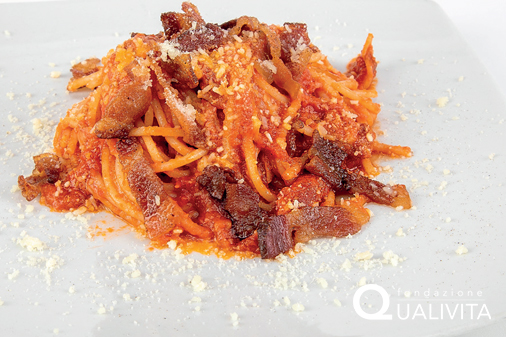Description
Amatriciana Tradizionale STG is a pasta sauce obtained according to a preparation method that involves the use of specific ingredients which determine its distinctive characteristics. It is distinguished by two varieties: sauce for immediate consumption and sauce for deferred consumption.
Production Area
The original traditional production area of Amatriciana Tradizionale STG was within the area of the Laga Mountains, which coincides with the territory of the municipality of Amatrice, in the Province of Rieti, in the Lazio region. Amatriciana Tradizionale STG subsequently became part of the gastronomic tradition throughout Italy.
Production Method
One of the basic ingredients of the sauce is Amatriciano pig cheek, which is between 18 and 30% of the total product. It is traditionally white with red streaks inside and the fat content is higher than the lean content. It is cured for at least 30 days under salt and natural herbs, garlic, black pepper and chilli pepper. The other mandatory ingredients are extra virgin olive oil (0.5-1%), tomato puree and/or chopped peeled tomatoes (69-81%), salt, white wine, chilli pepper (dried or fresh) and/or pepper to taste. For the preparation of both types of Amatriciana Tradizionale STG, the pig cheek is cut into strips and browned until it turns golden yellow, after which it is simmered in a little white wine until the liquid evaporates. For the sauce destined for immediate consumption, the crispy pig cheek should then be removed from the oil and put to one side. The other ingredients are then cooked in same oil for about 10-20 minutes, after which the pig cheek is added and the sauce is cooked for a further 5-10 minutes. Two different procedures can be used for the sauce destined for deferred consumption: the tomatoes and other herbs can either be added directly to the browned pig cheek in the pan, or cooked separately in the cooking oil and then mixed with the pig cheek. Amatriciana Tradizionale TSG is best sprinkled with grated Amatriciano pecorino or Pecorino Romano PDO.
Appearance and Flavour
Amatriciana Tradizionale STG is red, varying in intensity depending on the tomato puree and/or chopped peeled tomatoes that are used. The flavour is characterised by savoury notes given to the seasoned pig cheek and possible spicy notes from the chilli pepper.
History
There are many historical sources attesting to the tradition of this product. There are references to the processing and curing of pig cheek in the Statistics of the Kingdom of Naples, known as the Statistica Murattiana, which dates back to the Napoleonic occupation between 1806 and 1815. In 1847, King Ferdinand II of Bourbon, who was the guest of some noble families in Amatrice, said to a young guest: “Guagliò, dammene un altro piatto” (Boy, give me another plate). Amatriciana’s predecessor was a "white" sauce called Gricia, when the city of Amatrice was part of the ancient Abruzzo; it later became red when the tomato arrived in Italy.
Gastronomy
Amatriciana Tradizionale STG sauce for deferred consumption can be pasteurised or unpasteurised. The unpasteurised variety must be kept in the refrigerator at a temperature between 0 and 4 °C. The pasteurised variety is best stored in cool environments, away from direct light and heat sources. Amatriciana Tradizionale STG is commonly used as a condiment for pasta. The Roman tradition pairs it with spaghetti, but short pasta is allowed as an alternative, such as mezze maniche. Amatriciana sauce is best paired with a medium-structured, fresh red wine that is fairly smooth and not very old.
Marketing
The product is marketed as Amatriciana Tradizionale STG and is available year-round as sauce for immediate consumption and sauce for deferred consumption. The latter can be unpasteurised, found in the refrigerated goods section, or pasteurised, found on shelves, and must be packaged and labelled in suitable food-grade containers of up to 5 kg, or frozen at origin.
Distinctive Features
The ingredient that makes Amatriciana Tradizionale STG unique is the Amatriciano pig cheek, which thanks to having a higher fat content then bacon, determines the sauce’s intense taste.







